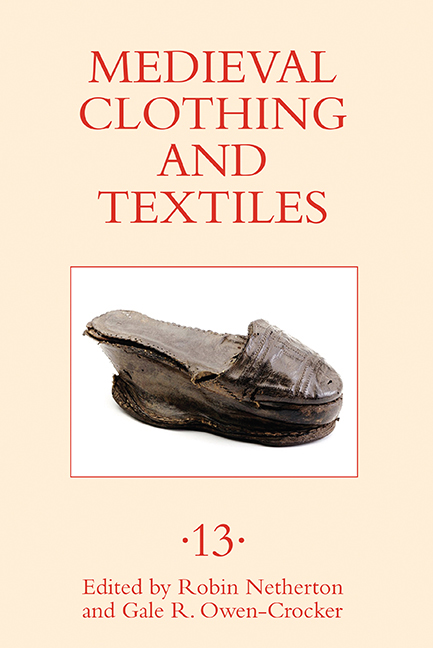Book contents
- Frontmatter
- Contents
- Illustrations
- Tables
- Contributors
- Preface
- 1 The Significance of Dress in the Bayeux Tapestry
- 2 How Long Is a Launce? Units of Measure for Cloth in Late Medieval Britain
- 3 Robes, Turbans, and Beards: “Ethnic Passing” in Decameron 10.9
- 4 Calciamentum: Footwear in Late Medieval Lucca
- 5 “Bene in ordene et bene ornata“: Eleonora d’Aragona’s Description of Her Suite of Rooms in a Roman Palace of the Late Fifteenth Century
- 6 The Lübeck Wappenröcke: Distinctive Style in Fifteenth-Century German Fabric Armor
- Recent Books of Interest
- Contents of Previous Volumes
3 - Robes, Turbans, and Beards: “Ethnic Passing” in Decameron 10.9
Published online by Cambridge University Press: 12 August 2020
- Frontmatter
- Contents
- Illustrations
- Tables
- Contributors
- Preface
- 1 The Significance of Dress in the Bayeux Tapestry
- 2 How Long Is a Launce? Units of Measure for Cloth in Late Medieval Britain
- 3 Robes, Turbans, and Beards: “Ethnic Passing” in Decameron 10.9
- 4 Calciamentum: Footwear in Late Medieval Lucca
- 5 “Bene in ordene et bene ornata“: Eleonora d’Aragona’s Description of Her Suite of Rooms in a Roman Palace of the Late Fifteenth Century
- 6 The Lübeck Wappenröcke: Distinctive Style in Fifteenth-Century German Fabric Armor
- Recent Books of Interest
- Contents of Previous Volumes
Summary
One of the first literary instances of donning attire to go incognito occurs when Odysseus arrives at Ithaca and prepares, with the help of Athene, a much-awaited return to his kingdom and his wife. Upon “changing his clothing into a shabby cloak and tunic … a large and well-worn hide of a nimble stag,” a staff, and a knapsack, Odysseus is ready to impersonate someone he is not. Odysseus conceals his identity by dressing down; so to speak, the king becomes a beggar through this clothing. Here, as well as in many other narratives and chronicles, sartorial elements are useful to communicate or to hide cultural identity and social status. Since the Odyssey was written, plenty of characters have crossed over lines of specific identity categories—gender, class or social standing, ethnicity, age, among others—through the use of textiles and other adornments.
Representing a different social status—rank, class, or degree—is a very common event in medieval literature. In Susan Crane's words, “[p]erhaps the most obvious function of clothing is to express and enforce standards of appropriateness … to mark social position, age, gender, season, and even time of day.” But medieval literature provides numerous examples of clothing signifiers also concealing a character's social status. This is particularly evident in chivalric romances, as Monica L. Wright explains, where “characters are clearly able to disguise themselves by wearing clothes that do not associate them with their normal identities.” These characters hide their identity or disguise themselves to perform (in most cases) a lower-status role that provides some form of mobility: They “dress down,” though social status habitually “shines through” despite the sartorial performances. Nevertheless, dressing “up” or “down” can also refer to other identity markers. Gender and social position are two identity categories often displayed within medieval narratives; yet in exploring courtly performances, Crane does not consider issues of faith or ethnicity. Indeed, Crane argues for an exploration of “self-conception” of secular elites, though we can further this understanding of medieval identity if we incorporate the representation of ethnicity or religious belonging.
The performativity of gender, social rank, and religious persuasion through sartorial elements in many medieval texts clearly serves to uphold the established hierarchy—what we often call status quo. Gender performance in medieval literature emphasizes the desirability of the dominant status (particularly maleness) and the privileges associated with it.
- Type
- Chapter
- Information
- Medieval Clothing and Textiles 13 , pp. 67 - 82Publisher: Boydell & BrewerPrint publication year: 2017

